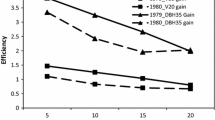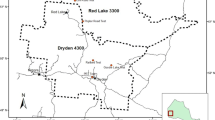Abstract
Ten-year data on growth and survival of two red alder provenance-progeny test trials located in the southern and northern coastal regions in British Columbia, Canada, were analysed and their implications for the genetic improvement of this species were discussed. A total of 42 and 41 provenances, each represented by two to five open-pollinated families were evaluated at each site, respectively. Results indicate that red alder provenances responded differently to the environmental conditions of the two sites. At age 10, red alder provenances tended to perform better at sites near their origin. The results support earlier work that two breeding zones should be delineated with the boundary at approximately 52° N. One may expect an average of about 5% decrease in stem volume and 6% increase in mortality, respectively, for each degree of southward and northward transfer of seed sources from their origins. Individual, family, and within-family heritabilities for height, diameter, stem volume were moderately high (0.22–0.42), for the southern zone, implying good potential for genetic improvement. Heritabilities were somewhat lower (0.12–0.39) for the northern zone because of greater environmental heterogeneity of the test site. Selecting the top 20 unrelated individuals for seed orchard establishment would result in 29% and 23% gain in stem volume at a rotation age of 40 years in the southern and northern zones, respectively. Correlation between ranks of the predicted breeding values for height at different ages and stem volume at age 10 increased rapidly when plantation was young and became relatively stable after 6 years of out-planting. Stem volume had much stronger correlation with diameter (≥0.84) than with height (≤0.67). Early selection at age 6 based on stem volume is therefore recommended.



Similar content being viewed by others
References
Brackett M (1973) Notes on tarif tree volume computation. Resource Management Report No. 24 (DNR Report No. 24). State of Washington, Department of Natural Resources. p 28
Cornelius J (1994) Heritabilities and additive genetic coefficients of variation in forest trees. Can J For Res 24:372–379
Dang QL, Xie C-Y, Ying CC, Guy RD (1994) Genetic variation of ecophysiological traits in red alder (Alnus rubra Bong.). Can J For Res 24:2150–2156
Hamann A (1999) Utilization and management of red alder genetic resources in British Columbia. Ph.D. Dissertation, University of British Columbia, Vancouver, BC
Hamann A, El-Kassaby YA, Koshy MP, Namkoong G (1998) Multivariate analysis of allozymic and quantitative trait variation in Alnus rubra: geographic patterns and evolutionary implications. Can J For Res 28:1557–1565
Hamann A, Koshy MP, Namkoong G, Ying CC (2000) Genotype × environment interactions in Alnus rubra: developing seed zones and seed-transfer guidelines with spatial statistics and GIS. For Ecol Manage 136:107–119
Hughes N (2005) Alder management: the British Columbia perspective. Power point presentation on the International Symposium on Red Alder: a state of knowledge. www.ruraltech.org/video/2005/alder_symposium/
Lambeth CC (1980) Juvenile-mature correlations in Pinaceae and implications for early selection. For Sci 26:571–580
Peterson EB, Ahrens GR, Peterson NM (1996) Red alder managers’ handbook for British Columbia. FRDA Report 240, ISSN 0835-0752. Can. For. Serv. and BC Min. For., Victoria, BC, Canada
SAS Institute Inc (1988) SAS procedure guide, release 6.03 ed. SAS Institute Inc, Cary, NC
Satterthwaite FE (1946) An approximate distribution of estimates of variance components. Biom Bull 2:110–114
Sokal RR, Rohlf FJ (1981) Biometry, the principles and practice of statistics in biological research, 2nd edn. W. H. Freeman and Company, San Francisco, p 859
Tanaka Y, Brotherton P, Hostetter S, Chapman D, Dyce S, Belanger J, Johnson J, Duke D (1997) The operational planting stock quality testing program at Weyerhaeuser. New For 13:423–437
Turner J (2005) Symposium highlights red alder. Link volume 7, issue 1. page 21. Published by FORREX, Forest Research Extension Partnership, Suite 702, 235 1st Ave., Kamloops, BC, V2C 3J4
White TL, Hodge GR (1989) Predicting breeding values with applications in forest tree improvement. Kluwer Academic Publ., Boston, p 367
Xie C-Y, Yanchuk AD (2003) Breeding values of parental trees, genetic worth of seed orchard seedlots, and yields of improved stocks in British Columbia. West J Appl For 18:88–100
Xie C-Y, Ying CC, Courtin P (1996) Genetic variability and performance of red alder (Alnus rubra) in British Columbia. Proc Ecol Manage Of BC Hardwoods. Dec. 1 and 2, 1993, Richmond, British Columbia
Xie C-Y, El-Kassaby YA, Ying CC (2002) Genetics of red alder (Alnus rRubra Bong.) populations in British Columbia and its implications for gene resources management. New For 24:97–112
Acknowledgements
Dr. Cheng Ying, the former Provenance Forester (retired), established the test trials. Dr. Alvin Yanchuk and Dr. Greg O’Neil reviewed an early draft of the manuscript and contributed valuable comments. Comments from an anonymous reviewer are greatly appreciated. Test site maintenance by Doug Ashbee and data management by Lesley McKnight are also acknowledged.
Author information
Authors and Affiliations
Corresponding author
Rights and permissions
About this article
Cite this article
Xie, CY. Ten-year results from red alder (Alnus rubra Bong.) provenance-progeny testing and their implications for genetic improvement. New Forests 36, 273–284 (2008). https://doi.org/10.1007/s11056-008-9098-3
Received:
Accepted:
Published:
Issue Date:
DOI: https://doi.org/10.1007/s11056-008-9098-3




